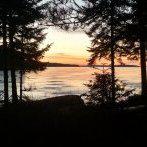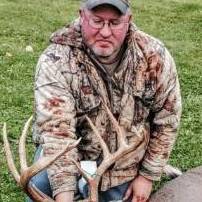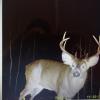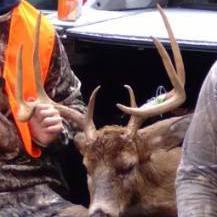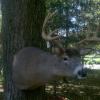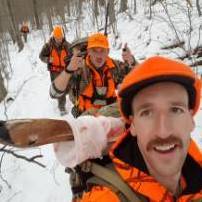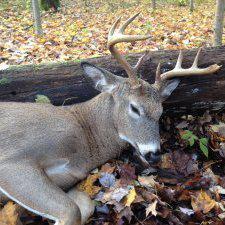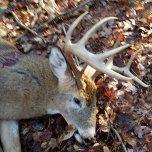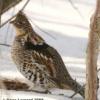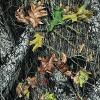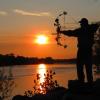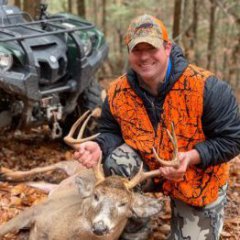Leaderboard
Popular Content
Showing content with the highest reputation on 08/09/21 in all areas
-
6 points
-
Things might be looking up on my corner of 9F. My wife ran into a bachelor group of 6 or 7, right near the road on the back side of my block, on her way home from the grocery store yesterday. She took some pictures and these two looked like pics of the litter. The others looked like smaller 8's and 6's. The one on the left looks like a shooter, but I would also settle for the one on the right.5 points
-
Doing my biggest whole hog this coming weekend for a customer. Butterflied 100lb. The issue is they are sourcing the hog. I know my guy will be within a few lbs of what I want. I'm concerned there guy might hand me a hog much bigger. My biggest was 140 for a buddy(not a paying customer). 18 hr smoke I've done countless 60 to 80 lb hogs, and enjoy the smiles and the comments of it's the most memorable and tasty the guests have had ever had. Just hoping they give me what they are saying I'm supposed to be cooking.5 points
-
4 points
-
Just prepared a spot for peas and oats. Did real well with that combo last year in this area. Will put in a bit bigger one in the next field up.4 points
-
Went out for a scouting trip today. Found a killer spot not far from the road. It has easily a couple 100 rubs scattered in there. Found a bunch of old and new beds. All surrounded by apple trees. Also had a community rub in the bottom of 3 ridges. Trails are down to dirt. So I have a camera in there just to let it soak for a couple weeks just to see what's going on then I'll leave it alone until I get the right wind.3 points
-
I only keep my cameras.in easy access areas.. learned long time ago to stay outnof sanctuaries, think spots and any place I would leave scent.. my only.interest is to see what is around area.3 points
-
3 points
-
Trying to come up with something clever, but I got nothing. It's a big beautiful world, fellows, and yours to explore.3 points
-
My brother uses a drone to fish. But, he’s quadriplegic and it’s the only he can fish. When I first saw this thread, I thought it was him. He’s been crushing porgies on the north shore this past week.3 points
-
3 points
-
As some of you may know I got into trapping the last two years. I tried to chronicle some of the catches on here. It got me thinking of the course NY puts on and how we can better help those that want to get into trapping as a hobby or part of their property management strategy. I have started planning a late summer trapping education even. Details to follow. It will be a day and a half event. Looking like September 11th and 12th. Full day on the 11th and 1/2 a day on the 12th. One of the issues I had with the normal format for the hunters education classes is there is little time for actual hands on or spending time in the field learning some tips. SO, in the spirit of the Filed to Fork program we are going to take this one event in a different direction. Day one will be the normal Trapping education event so you will have the certification to get your license. Day two will be hands on and work in the filed. You will learn how to set the different types of traps, how to make the basic sets, learn the basic use of lures and baits and start the learning process on where to set and why. We are trying to get folks involved and help to shorten the learning curve. Since I have a few fox frozen from last season we are also going to be doing a skinning and fleshing demonstration. This was one of the biggest voids in the normal curriculum. We are going to limit this to 24 participants and those attending must be NDA members but attending the course will be free otherwise. (Those of you that bought the membership raffles are a leg up on this part) Stay tuned for further details.2 points
-
So my brother on L.I. is a surf rat. This is his rig. Guy pulls up next to him and has a drone that will drop bait at 400 yards off shore. I don't love the idea but wow aint that something.2 points
-
Hi Everyone, my name is Billy Harvey and I am a new member to the forum. Wanted to introduce myself and share about my local hunting podcast that my friends and I are doing called the Pertnear Outdoors Podcast. http://inktr.ee/pertnearoutdoors We started the show a couple years ago and have enjoyed getting to meet some great guests and built some awesome relationships so far. We have become actively engaged with the National Deer Association local chapters to raise some money through raffles and even brewing a beer with proceeds going to NDA and the Venison Donation Coalition. There are two events coming up soon here in WNY that we hope would interest many of you. This saturday 8-14 at 12pm is a Tethrd Teach and Train event at Allied Sportsmen in Alden on Clinton street. This is a free event and just need to sign up at the following link. Teach and Train signup Sunday 8-22 we are hosting a beer debut event at Windy Brew in Sheldon NY right on Rt. 20a. We will have basket raffles with some great prizes including tree stands, fishing gear, easton arrows and much more. We will also be raffling off a Traditions Nitrofire Muzzleloader. All proceeds from the event will be split between NDA and VDC. We hope to see you there. If anyone is interested in any other info, feel free to contact us on Instagram @pertnearoutdoorspodcast or on Facebook. Thanks and look forward to interacting with the group. Billy-2 points
-
Got the stuffed buck from the taxidermist 10 days ago and hung (on the left) on the wall. I'm not set on the placement of these two mounts on the wall yet as one faces left and one faces right. I have them facing opposing directions and it's kind of neat how when you walk into the room one (gun 2019) is looking right at you and when you flop into a seated position you see the newest one. I'm very happy with the final product from the taxidermist and hope (sincerely) I don't see him for a few years.2 points
-
Smoked eggplant and pork belley. Wouldn't do apple with the eggplant again but was still not bad. Pork belley was great.2 points
-
2 points
-
I apologize if this is long,, I feel its.worrh the read and perhaps you can enhance your own land.... Many people throughout the Northeastern United States have in the last several decades come to love the wild turkey. While many are happy just to see or hunt turkeys on other people's land, others want to manage their land to benefit turkeys. Let's take a look at what someone who owns 50-100 acres can expect to be able to do for the wild turkey. One of the first things you need to consider is how much area a turkey can normally be expected to cover, also known as its home range. A turkey can and does cover a lot of ground in its daily travels. Wild turkeys can cover up to 2 miles per hour while feeding. Their home range varies by season and can range from 400 to 2,000 acres or more. Therefore, unless you own a large tract of land (at least several hundred acres), you do not need to provide for all of a turkey's annual needs on your land. What you should do is look at your land and the surrounding area and determine what habitat component is in the shortest supply, and then try to provide that habitat type on your land. For instance, if your property is forested and surrounded by active agriculture, creating a small field will probably not be an effective method of attracting turkeys. Instead, maintaining it as a woodlot and managing for mature mast producing trees would be a better choice. When turkey management first began, biologists thought that turkeys required very large stands of mature timber to survive. It is now recognized that turkeys do best in areas with a wide variety of habitat types and plant species. One recent researcher has described the ideal turkey habitat as one-half wooded, one quarter abandoned fields and one-quarter active agriculture. In reality turkeys in the Northeast have three critical habitat needs that may be in short supply: 1) good nesting habitat, 2) good brood rearing habitat and 3) a good winter food source. If those three needs are met, interspersed with mature woodland, you have greatly increased the probability of having wild turkeys in the area. The only other component you might want to add is a late summer/fall food source. The primary benefit of this would be to hold the birds for your enjoyment, as fall food is seldom lacking in the Northeast. If you do manage your land for turkeys by providing improved habitat, just what can you really hope to accomplish? Before deciding on a method of enhancing the value of your land for wild turkeys, think about your objectives. Do you want to be able to observe the birds year round or are there certain times of the year when you are more interested in having turkeys use your land? Wild turkeys respond well to habitat enhancement techniques such as food plots. Therefore, it is possible to attract the birds to your land. But because of their mobility and tendency to roam don't expect to see them every day! If you do decide to manage your land for wild turkeys, you will have the enjoyment of knowing you have a few more turkeys on your land. In many cases, they will be visible so you can enjoy watching them. Even if they are not visible from your house, you will have the enjoyment of knowing that they are using your property and you have improved their habitat. In terms of actual impacts on the turkey population, unless you provide a large amount of a critical habitat component that is seriously lacking, the impact on the population will be minimal. You can, however, improve nest success, poult survival or over winter survival in your immediate area. Remember too that you will be benefiting other wildlife species as well, such as deer, rabbits, and numerous songbirds, to name a few. You can have excellent turkey habitat because of the diversity in Your landscape. Our woodlands, adjacent to agricultural or abandoned fields and hedgerows provide ample nesting habitat. Herbaceous openings, such as log landings in wooded areas, hay fields, orchards and pastures provide high quality brood habitat. Waste grain from silage, corn and small grain production provides late summer and fall food. The abundance of oak, hickory and beech nuts in our forestlands supply nutritious foods for the winter, as well as manure spread on the fields during late winter months. This habitat mosaic is a key to our sizable wild turkey population. Brood Habitat After the poults hatch, they require good brood habitat for survival and growth. Brood habitat generally consists of grasses and forbes, areas with abundant insect life, that the poults need as a food supply for growth. The ground cover should be dense enough to encourage insects, but not so dense as to inhibit the poults' movement. Brood habitat must be near or adjacent to brushy and wooded areas for escape cover and trees for roosting. Orchards or groves of trees spaced widely enough to allow sunlight penetration and allow room for mowing provide ideal brood habitat when the grassy areas are mowed once or twice a year. The trees provide overhead cover making the hens feel more secure. Additionally, the fruit trees will provide an excellent fall, early winter food supply. The following are some suggestions for managing specific habitats for brood habitat. Remember these are suggestions only, there are no hard and fast rules and you can decide what methods you wish to employ on your land. Assistance with soil testing or fertilizer aliming recommendations is available through your local Cooperative Extension Office. Log landings & roads: Lime and seed to grasses and clovers at the end of the logging operation. These areas generally need annual mowing to control weedy invasion and re-application of fertilizer and lime and over-seeding every few years, depending on your soil type. These treatments are known as "top-dressing". Clover mixes should not be mowed lower than six inches. Power lines and other right-of-ways: Encourage regular maintenance by the power company to maintain grasses and forbes. Mid to late summer mowing is best. Some companies have vegetation management policies that allow establishment of low-growing shrubs and trees on their right-of-ways. If not, encourage the company to do so for wildlife. Songbirds and other wildlife benefit greatly from these habitats as well. Hay fields: Delay mowing as long as possible (at least until mid-July). Use taller less dense grasses like timothy, orchard grass, perennial rye and white clover or use warm season grasses like switch grasses and/or blue stem that mature later and can be cut for hay in late July. Alternatively, mow the perimeter of the field, or strips, throughout the growing season, to provide short vegetation for young poults to travel and feed in, adjacent to taller vegetation for escape cover. Pastures & old fields: Leave some trees (apple, black locust, crab apple, black haw, wild raisin, ash, oaks, cherry, etc.) to create a savannah type habitat. In pastures, grazing will maintain a short grass cover. In old fields encourage grasses and forbes by periodic mowing or spot herbicide application to discourage woody brush. If dense grasses exist, annual mowing may be necessary. Perennial food plots and openings: Test soil, lime and fertilize as necessary prior to planting. Plant to clovers, native grasses, and lower lespedeza varieties. When necessary, mow very late fall or early spring. Reseed only as necessary every 5+ years. Alternatively, mow the perimeter or strips, throughout the growing season. Occasional top-dressing with lime and fertilizer will help to maintain grasses and legumes. If you notice invasion by weeds, test the soil and add the amount of lime and fertilizer needed. Annual food plots: Test soil, lime and fertilize as necessary. Plant either pure or mixed stands of oats, buckwheat, sunflower, sorghum, and/or corn. If deer are overabundant, buckwheat will be very difficult to establish. You may have more success with corn, sorghum, and sunflower. Nesting Habitat For optimal reproduction turkeys require good nesting habitat. Wild turkey hens begin to nest before most of the new growth begins in the spring. Therefore, at least for initial nests, hens need some residual cover from the previous year to conceal their nest from predators. Generally, nesting habitat consists of low, horizontal cover such as low brush, standing raspberry canes from last year or anything that obstructs visibility between ground level and about 3 feet. Woodlands that have been over-browsed by deer do not provide safe nesting cover. Mature woodlands with a well-developed understory provides excellent habitat. In wooded areas, turkeys often nest at the base of a tree, fallen log, ea boulder, which provide additional concealment from predators. Be sure there are numerous patches of low cover in the vicinity. If there are only a few patches, predators will learn to search those specific spots and your management can do more harm than good. Patches of brushy cover will be used no matter where they are located, but it is better if nesting cover is close to brood habitat. Later in the spring when new growth begins, hens will readily renest in areas that are not acceptable earlier. The following are some suggestions for managing some specific habitat types for nesting habitat. Remember these are suggestions only, there are no hard and fast rules and you can decide what methods you wish to employ on your land. Logged areas: Leave some scattered tops, but clear some of the tops and branches to allow natural regeneration, and create brush piles with the cleared debris. Note, if overbrowsing by deer is a problem, keep most of the tops and branches in place, which will make it difficult for deer to browse the seedlings that grow within the brush. If grassy openings are lacking in the vicinity, convert the log landing, and possibly some of the logging roads, into permanent openings by seeding to grasses and legumes. Woodlot edges: Thin (remove some of the trees to let sunlight reach the ground) up to 50 feet adjacent to open areas to encourage shrubs and brushy growth. Keep native fruit and nut producing shrubs such as dogwoods, viburnums, hawthornes, etc. Leave some scattered treetops or branches for horizontal cover. Utility Rights-of-ways: Such as power-line cuts, pipelines. These habitats provide well-developed vegetation up to 3-5 feet above the ground. Work with the power company to allow shrubs and brushy vegetative growth. Delay cutting or spraying in these areas until nesting is completed (mid July). Contact the utility company as utility companies usually are willing to work with landowners to manage these areas for wildlife. Hay fields, pastures: Many renesting hens will use hayfields. Delay mowing as long as possible (at least mid July). Hay and pasture seed mixes should contain taller less dense grasses like timothy, orchard grass, perennial rye and white clover. Avoid cool season grass mixtures that contain fescue as they can develop thick sod and stems, which young turkeys may have difficulty traveling through. You can consider native warm season grasses like switch grasses and/or blue stem that mature later and can be cut for hay in late July. Old fields: Maintain shrubby patches within the old field, cut brush & trees and leave scattered piles of branches, mow periodically to keep much of the field in grasses or other herbaceous cover. Encourage clumps of raspberry, blackberry, goldenrod and aster, (any heavy stem herbaceous cover) by brush-hogging every two to three years. Late Summer and Fall Habitat Late summer and fall habitat is generally the least limiting of a wild turkey's needs in the Northeast. It is, however, a time that many wild turkey enthusiasts want to see wild turkeys using their land. At this time of year a turkey needs wooded areas for concealment, roosting trees and a good food supply to ensure they enter the winter months in good physical condition. The following are suggestions for managing specific habitats for late summer and fall habitat. Remember these are suggestions only, there are no hard and fast rules and you can decide what methods you wish to employ on your land. Assistance with soil testing or fertilizer and liming recommendations is available through your local Cooperative Extension Office. Log landings & roads: Lime & seed to grasses, sedges (nut grasses) and clovers at the end of the logging operation. Generally these areas need mowing to control weedy invasion and re-application of fertilizer and lime and over-seeding every few years. Plant mast producing shrubs such as crab apples, hazelnut, serviceberry, dogwoods, and viburnums in clumps on the landings, or along the edges. Hardwood timber: Manage for a variety of different dependable mast producing species (such as oak, beech, cherry, ash, black walnut, hickory). Have a timber management plan developed in consultation with a professional forester to manage for your goals (e.g. an uninterrupted mast production and regeneration of those species). In Pennsylvania, assistance to private landowners is available through the Penn State University Forest Stewardship Program. Don't forget the mid and understory mast producing species such as hop hornbeam, ironwood, hazelnut, serviceberry, dogwoods, and viburnums. Stay away from planting exotic, invasive bushes such as Russian and autumn olive and Japanese barberry. Perennial food plots and shrubs: Test soil, lime and fertilize as necessary. Plant clovers, grasses and lower lespedeza varieties. Alternatively, mow the perimeter or strips, throughout the growing season. When necessary, mow in very late fall or early spring. Reseed only as necessary (every 5+ years). Plant fruit producing trees and shrubs such as apple, crab apple, hawthorn, dogwoods, viburnums, highbush cranberry (in moist areas), staghorn sumac, and/or grapes. Discourage exotics like Russian olive, autumn olive and multiflora rose. Shrubs may be planted in "hedgerow" type arrangements. Trees planted in perennial food plots may be arranged on the edge of the plot that receives the most sun (preferably adjacent to the forest edge.) Trees may also be planted orchard-style with 15 to 25 foot spacing. Plant in a manner so you can easily mow around them. Annual food plots: Annual food plots should be small ½ to 2½ acres. Test soil, lime and fertilize as necessary. For corn, plant at normal time and leave standing to provide food into the winter. Plant a mix of sorghum, millet, and sunflower in late spring and leave standing. Buckwheat should be planted later than normal (mid June to early July) for fall food source. Leave standing and over-seed with rye in September. If deer are overabundant in your area, buckwheat will be very difficult to establish. Plant rye and wheat in September for a source of fall and spring food. Pure stands of sunflower should be at least ½ acre in size to protect from deer. Also, in southern to central Pennsylvania, c(Cyperus esculentus var. sativus), an African variety of the native nutsedge, is an excelleannual food for turkeys. Native nutsedges can be a problem weed in some areas. Chufa is not aggressive and will not create problems when other crops are planted after it. The nut like tubers, which grow under the ground, are relished by wild turkeys and other wildlife inthe fall and early winter, until the ground freezes. Crop fields: Plant and harvest grain crops such as corn or oats in the normal manner leaving some at the edges of the fields standing. Try to leave at least ten rows standing whenever possible. Winter Habitat In Northern New England, Eastern Canada, northern New York, and to a lesser extent northern Pennsylvania and high elevations of PA, such as the Laurel highlands, winter habitat is crucial for the survival of wild turkeys during extreme winters. In some parts of North America, turkeys exist north of their historic range. This is primarily because of habitat changes, such as farming in the St. Lawrence and Champlain Valleys, and the conversion to northern hardwood forests from pine and hemlock forests in northcentral Pennsylvania. During extreme winters, wild turkeys need a dependable food source that is close to thermal roosting cover and protected travel corridors. In south and central Pennsylvania and at lower elevations, there is less difference between fall and winter habitat. The following are suggestions for managing specific habitats for winter habitat. Remember these are suggestions only, there are no hard and fast rules and you can decide what methods you wish to employ on your land. Assistance with soil testing or fertilizer and liming recommendations is available through your local cooperative extension.Spring Seeps: Spring seeps (spots where ground water comes to the surface) are found in old pastures, fields and in the forest. The warmer ground water keeps snow melted arothe seep. The plant and animal life found in and near spring seeps are important winter food sources for turkeys and other wildlife. All seeps can be useful but seeps on south-facing slopes are most valuable. Seeps may be managed or simply left alone. In foresteseeps management can include stimulating the growth of herbaceous plants within theseep by removing some of the forest canopy. However leave about 70 percent canopy closure to keep water temperature cool and not to create a thicket of understory growth. Remove unproductive trees and leave mast-producing trees near the seep. Seeps in open areas may be improved by keeping them from being invaded by varieties of woody stems that do not produce food items. Planting fruit bearing shrubs near but not in the seeps cprovide accessible winter food. If necessary, fence the seep to keep cattle out. Annual food plots: If possible, place food plots for winter use on south facing slopes to take advantage of the sun's radiant energy. Test the soil, lime and fertilize as necessary. For corn, plant at the normal time and leave standing to provide food into the winter. In areas of high deer numbers, plant larger plots of corn (2 - 5 acres). Plant a mix of sorghum, millet, and sunflower in late spring and leave standing. Buckwheat should be planted later than normal (mid June to early July) for fall food source. Leave standing and over-seed with rye in September. If deer are overabundant in your area, buckwheat will be very difficult to establish. Plant rye and wheat in September for a source of fall and spring food. Pure stands of sunflower should be at least ½ acre in size to protect from deer. Thermal cover: Conifer stands provide a windbreak, roost sites, protection from extreme cold and limit snow depth under the stand allowing turkeys to be mobile. Provide several acres of conifer trees for every hundred acres of habitat. Eastern hemlock and white pine are good but most species of native conifers will help. Plant conifers in clumps or strips to provide the best thermal protection. When planting conifers, plant in open areas to allow them to quickly grow because they are intolerant of shade during their early years. Hardwood timber and tall shrubs: Manage for a variety of different dependable mast producing species (such as oak, beech, cherry, ash, black walnut, hickory). Develop a timber management plan in consultation with a professional forester to manage for your goals (e.g., uninterrupted mast production and regeneration of those species). In Pennsylvania, assistance to private landowners is available through the Penn State University, Forest Stewardship Program. Don't forget the mid story mast producing species such as hop hornbeam, ironwood, hazelnut, serviceberry, dogwoods, and viburnums. Plant fruit producing trees and shrubs such as apple, crab apple, hawthorn, dogwoods, viburnums, highbush cranberry, staghorn sumac, and grapes. Discourage exotics like Russian olive, autumn olive, and multiflora rose. Travel Corridors: During deep snow conditions turkeys will use travel corridors created bconifer cover. By providing narrow strips of conifer cover between other habitat types, turkeys will be able to move more freely2 points
-
Remember you lose 1/2 in diameter of that rack for.velvet.. 2.5 is my final answer2 points
-
Angle the camera more so it's less perpendicular to the area you are monitoring. Or place small 1/16-1/8" electrical tape on each side of sensor. The sensing is wider than FOV when matched with the trigger speed - prime example of why trigger speed claims don't mean much without a matched sensing capability and FOV.2 points
-
Thanks! Wish I could live there permanently but still got bills to pay. Winsted CT great town & escape from communist NYC! Sent from my iPhone using Tapatalk2 points
-
2 points
-
2 points
-
2 points
-
2 points
-
It would be wonderful if both sides of the vax argument would focus on holding the people accountable for releasing it into the public.2 points
-
2 points
-
2 points
-
2 points
-
As a NYS Hunter Ed Instructor, I may be a bit biased, but in person instruction can give so much more, as far as hands on learning. I think most retain more of the course with the in person, hands on approach. JMO The online course is easy enough though.2 points
-
Absolutely not! I may decide to lean one way or the other but this is a personal choice and in no way does society have the right to tell me what I should or should not do. Hate to bring this up, again, but this is the exact same thing as the abortion debate. I personally, don't think we should be killing the unborn by the millions, but I don't feel that gives me the right to either ostracize or vilify those that have it done. When my wife was pregnant with our first, the hospital tried to convince us to terminate the pregnancy claiming my son would probably be severely autistic. She asked me what we should do. I told her we would love the baby no matter what. He is now 17, the picture of health and an honor student!! Imagine if we took their advise.2 points
-
1 point
-
Interesting read. I don't have much to work with, land wise, but I made an effort this year to do what I could. In the spring, I turned the back half of my back yard into a mini-foodplot and planted clover and chicory for the deer and turkeys. We have ag in the area, but there's no clover around. I thought it would be easy for me to plant and maintain and provide the deer and turkeys with something they love and aren't getting elsewhere. I now have 6 hens that are in my yard 2x/day, morning and evening. spending 4-5hrs/day feeding, preening, and lounging in the shade in my measly 1/2 acre yard. They must be pretty content spending that much of their day in my dinky clover plot. Plus, being in my yard, they probably feel safe from predators. I started thinning out the nest raiders last fall, so that should help too.1 point
-
Really thin looking neck eh! Head neck and rack say 2.3 to me but that body, I'll push him to 3.3.1 point
-
1 point
-
1 point
-
1 point
-
Yeah, one lower plot I had to raise the hydraulics on the disc about a dozen times to get out of the mud. Wound up just pulling it downhill through the wet area. Still pretty flipping wet.1 point
-
1 point
-
1 point
-
Check the pocket of the coat you wore on your last hunt. That’s where mine was!1 point
-
1 point
-
Venison sloppy Joe's with onions, jalepenos and tomatoes from the garden. A little sweet baby rays. Really good. Breaded fried zucchini.1 point
-
1 point
-
1 point
-
I saw 3 nice bog bucks last night . Wow they were beautiful. No thp boys at wedding . But meet some cool people .1 point
-
1 point
-
1 point
-
Winter rye is super easy to grow as long as you get seed to soil contact. I like to broadcast it into soybeans as the leaves yellow.1 point

